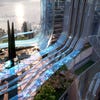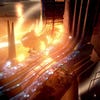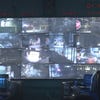Spec Analysis: PlayStation 4
Digital Foundry's take on the final confirmed spec, the capabilities of the hardware - and the surprise 8GB announcement.
The official specs are in for the PlayStation 4 and what we have is, by and large, confirmation of existing Digital Foundry stories - with one outstanding, exciting exception. At the PlayStation Meeting yesterday, Sony revealed that its new console ships with 8GB of GDDR5 RAM, not the 4GB we previously reported. It was a pleasant surprise not just for us, but also for many game developers out there working on PS4 titles now and completely unaware of the upgrade - a final flourish to the design seemingly added in at the last moment to make PlayStation 4 the most technologically advanced games console of the next gaming era.
From an engineering perspective, it's a remarkable achievement. Sony itself doesn't fabricate memory, it buys from major suppliers who advertise the parts available months (sometimes years) ahead of delivery, so we have a decent idea of what options the platform holders have on the table in creating their next-gen systems. The GDDR5 memory modules - the same used in PC graphics cards - are only available in certain configurations, with the densest option available offering 512MB per module. The startling reality is that unless Sony has somehow got access to a larger chip that isn't yet in mass production and that nobody knows about, it has crammed 16 memory modules onto its PS4 motherboard. To illustrate the extent of the achievement, Nvidia's $1000 graphics card - the GeForce Titan - offers "just" 6GB of onboard GDDR5.
The availability of these modules has also been something of a moving target throughout the development of PlayStation 4. In many ways, the genesis of the new console has been an exercise in Sony learning from the harsh lessons brought about by the PS3's custom architecture. The split RAM memory pool didn't work out so well and a unified RAM set-up was always considered a must for the new console. Early rumours suggested that GDDR5 availability could even limit PS4 to just 2GB of memory, with 4GB at one point looking rather optimistic. What changed at Sony and encouraged them to go all out with its final design is not clear, but the chances are it would have been well aware of the RAM advantage offered up by its upcoming Xbox competitor, which - certainly up to its beta hardware at least - features 8GB of more bandwidth-constrained DDR3. What shouldn't be understated is the amount of extra cash this is going to add to PlayStation 4's BOM (bill of materials) - this is an expensive, massive investment for the company.
So what does this mean for Sony and for next-gen gaming in general? First up, unless Microsoft has radically upgraded its graphics and memory configuration for Durango in the last nine months (an engineering nightmare unlikely to happen - it can't really add more chips as Sony has done), the PlayStation makers have less to worry about in terms of any direct hardware comparisons with their competition. GDDR5 latency is higher than DDR3 but the bandwidth advantage is substantial, while confirmation of the impressive Radeon graphics core puts to bed the era of PS3 developers struggling with sub-par GPU hardware. However, more importantly, many developers attest that it's the amount of RAM available that defines the longevity of a fixed platform. Historically, a console generation is typically defined by a 6-8x increase in technological power - both Microsoft and Sony have pushed the boat out with a 16x boost to system RAM over their current-gen predecessors - the strongest indication of any that these new machines are built to last.
Rumour confirmation: x86-64 Jaguar cores, big GPU - on one APU
From a raw specs point of view, the RAM upgrade was the biggest - and only - major surprise of the evening, though some elements have come to light which change our thinking on other elements of the PS4 design. We have confirmation of the eight-core Jaguar CPU architecture from AMD (x86 in nature, with 64-bit addressing - Sony calls it "x86-64") while we also see the 1.84 teraflop/18 compute unit metrics there in black and white for the Radeon GPU element of the PS4's "Liverpool" processor.
These two figures in combination also confirm that the graphics hardware runs at 800MHz, as we previously revealed. The mooted 176GB/s bandwidth for the GDDR5 RAM is also now official, suggesting a speed there of 5.5GHz effective - in line with most current Radeon graphics cards. Previous information had suggested that Sony would be splitting GPU resources between rendering and compute functions (VGLeaks suggesting a 14/4 compute unit split between them in its SDK document leak) but the official spec talks of a unified 18 CUs, which "can freely be applied to graphics, simulation tasks, or some mixture of the two". The divide appears to be gone, and devs can apply available power as they see fit.
Elsewhere, the released spec is thin on the ground in terms of specific detail and is effectively a sub-set of what was already revealed a couple of weeks back. There's confirmation of a built-in hard drive (but no indication of capacity - this is another moving target that Sony can select at will, just as it did with PS3), along with b/g/n WiFi, Bluetooth 2.1 and gigabit LAN.
"Sony has a hardware video encoder and it knows how to use it! The sharing of gameplay over IP was one of the impressive elements of the presentation."
The Blu-ray reader gets a decent enough upgrade from PS3's 2x drive, moving up to a 6x CAV (constant angular velocity) design, meaning maximum read speeds of around 27MB/s - though throughput will lower according to the area of the disc being read. The spec appears to be a very close match for the standard BD drives Sony itself currently produces, lending further evidence to the notion that we're looking at a cost-effective 50GB dual-layer unit rather than the more exotic 100GB quad-layer drives said to be coming in the future to accommodate 4K video playback.
On a basic level, the challenge here for developers will be to read data quickly enough from the optical drive in order to make use of that prodigious 8GB of RAM - we can foresee background installs as part of the picture here, loading up enough gameplay into memory to get going while more data is streamed onto HDD in the background. On PS3, we already see a number of titles that 'stealth install' onto the hard drive (many of them running on Unreal Engine 3, and Capcom's Dragon's Dogma being another) where read speeds are so much higher - even slower 2.5-inch drives can reach 100MB/s in their best case scenarios. Our hope is that the era of mandatory installs that keep you from getting at the game are a thing of the past. The signs look good: making the experience of using the console as friction-free as possible was a key part of Sony's presentation last night.
Where the official Sony spec provides new detail over the leaks is in regards to ports and sockets on the final PlayStation 4 hardware. Super-speed USB 3.0 ports are included (an unknown number of them, but two are on the front of the dev kits) while basic outputs appear to be a match for PlayStation 3: HDMI, multi-AV and toslink optical audio are confirmed. Curiously there is also mention of a mysterious "aux" input - a quick look at the spec of the new PlayStation 4 Eye confirms a dedicated connection for the dual cam.
"PC stood in for PS4 at several points in the event - the core processing elements in the new console are derived from AMD computer tech. In a fixed box system, the potential is immense."
Surrounding technology
Sony didn't confirm other elements of the PlayStation 4 specification, but we sure got to see them in action. Last weekend in an "In Theory" speculative piece, we discussed the emergence of hardware video encoders in modern gaming technology, drawing attention to how Steambox and Nvidia's Project Shield aim to stream gameplay around the home using a home-based implementation of cloud gaming technology. We also suggested that the same hardware in PlayStation 4 could be used to share gameplay over the internet, at the same time transforming PS Vita into a remarkable GamePad-like piece of kit.
The theory was sound, but we had no idea that Sony would be addressing the issue so completely so early on in the development of the new console - but there it was, and it looked magnificent. Based on assets released this morning by Sony, 1080p does indeed appear to be the new resolution standard for next-gen titles on PS4, meaning a clean 2x super-sampling effect when the same game is rendered on PS Vita. Video quality - as best we could tell from a livestream that wasn't really fit for purpose, actually serving to undermine Sony's presentation - looked good too.
However, what really impressed us was the imagination behind the technology. Remote play is just one element of the functionality on offer, with Sony utilising the video encoding hardware to offer up a range of benefits. We saw one of them in action last night with the Guerrilla Games' Killzone Shadow Fall demo uploading stored gameplay video directly onto Facebook. Also impressive was the mooted support for livestreaming via existing providers, along with the ability to introduce spectating with viewer comments appearing on-screen as you play. Elements of cloud functionality were also suggested, allowing for remote players to take over your game should you come across a particularly difficult section of the game.
"Sony hopes to support Remote Play for PS Vita on all PS4 titles - a shot in the arm for the handheld, though we wonder if it could cannibalise Vita game sales..."

Meanwhile, the possibilities of full-on cloud gaming were cautiously mentioned, the dream being instant access to the entire library of PlayStation titles across its entire history of hardware - PS1, PS2 and PSP should be no problem running under emulation on the erstwhile Gaikai cloud servers (Sony's in-house emulators are quite exceptional) but PS3 will be a challenge... however, it's the library of 3000 titles available for the most recent console that is explicitly mentioned in Sony's press material. Talk of a full streaming service was guarded: there seems to be tacit acceptance that internet infrastructure isn't really there yet, and that Sony is going to experiment on less critical elements, like game sampling, for example.
There was also talk of a new processing module in the PS4 hardware designed to handle tasks like background downloading. Our sources suggest a low-power ARM core designed to handle "standby" tasks along these lines, while the console also saves the current gameplay state when the system is closed down, meaning instant access to the last game you played when you power up again. OS tasks and resource allocation remain unknown (512MB or thereabouts was discussed with developers) but we now have some idea of what this system can do: Sony talks about running a web browser "and other applications" during gameplay.
But what about the games?
Almost 13 years ago now, we travelled to the Tokyo Game Show to take a look at the PlayStation 2 launch line-up and to check out some early demos - including the now almost mythical Gran Turismo 2000, the launch game that never came to be. We came away with the conclusion that while the visual leap was obviously immense, there was no fundamental new approach to gaming - this was effectively "PlayStation+". It would take months - years even - before the power of the platform was exercised to produce something genuinely new and exciting beyond the visual upgrade. Watching the livestream last night, and assessing the much higher quality assets released this morning, there's a similar feeling in response to this PS4 reveal. We love the technology, the ethos, the immediacy and the sharing of gameplay, but we're not enormously impressed with the games shown thus far.
Killzone Shadow Fall has moments of exceptional majesty and some beautiful animation, but the in-game concepts revealed last night failed to truly excite, and even in terms of technical accomplishment - something readily associated with Guerrilla Games - you put the video side-by-side with Crysis 2 and its sequel and it feels a step off the pace. Evolution's Driveclub went big on social gaming and an exceptional attention to detail on the car modelling, but there was no "Gran Turismo moment" - the feeling that you're seeing new hardware producing a revelatory experience. Perhaps it was the quality of the livestream but interior car modelling actually seemed to be a step down from GT5. Knack looked like fun but visually underwhelmed in the presentation while the assets released by Sony this morning look simply phenomenal - too good to be true, even. In the absence of proper gameplay to look at closely, the jury's out for now. The inFamous reveal also confused - is this real-time PS4 video? The poor livestream seemed to scream FMV, the assets we're looking at now suggest at least some elements are in-game, and look great.
"There's a sense that the power is there but that it'll take time for game developers to fully understand quite what to do with the new tools they have available."
It was down to Media Molecule to provide a hint of something genuinely new in its segment, but with no apparent game to hang its brilliant concepts around, there was some confusion about what this actually meant in terms of an actual experience - an end product we can actually play that tells us something about the developer's plans for the new console. However, Alex Evans' presentation was both cool and intriguing, also confirming that despite the migration of some PlayStation Move functionality to the new Dual Shock 4, the original Sony motion controller will still see support on PS4 in its own right.
Elsewhere, we saw other game demos not running on PS4 hardware, which is perhaps not surprising bearing in mind that final development kits for the new platform are a relatively recent phenomenon - something that almost certainly had an effect on what native wares we did actually see. Watch Dogs was confirmed after the event as running on PC hardware with specs equivalent to the PlayStation 4, while Square turned up with a re-heated outing of its existing Agni's Philosophy demo (said to be running on PS4, but we're sceptical). Capcom's new Panta Rhei engine, running its new Deep Down IP, looked really impressive but again it was unclear how the tech would translate into a final PS4 game. Our worry here is that the spectre of the target render has given way to in-engine video running on another, more powerful platform.
But similar to that underwhelming PlayStation showing two generations ago, we remain very hopeful: there's a sense that the power is there, that we've only seen the vaguest of hints of what it's truly capable of - and that it'll take time for game-makers to fully understand quite what to do with the new tools they have available. However, from what was shown last night the slightly worrying reality is that in the short term we're looking at games and demos either already running on PC, or with equivalents available now that simply look better.
Of course, it's early days yet: Sony may well be keeping its powder dry for a more fully formed E3 re-reveal - we've yet to see what the likes of Naughty Dog and Sony Santa Monica are doing with the hardware. An extra three months with final dev kits could make a lot of difference...




























